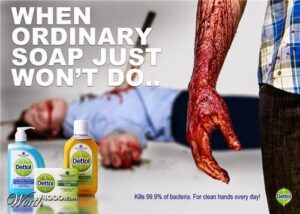Blood, Blades, and Bold Claims: Unpacking a Dettol Advertisement
The City College of New York
ENGL 21003: Writing for the Sciences
Professor Anna Voisard
June 10th, 2024
In the world of marketing, even a simple product like hand soap can evoke strong reactions from the audience. Promotional strategies can sometimes lead to unintended controversies, especially when the content seems inappropriate or offensive. Advertisements with provocative or shocking imagery can leave a lasting impression on anyone. A prime example of this is the 2010 Dettol ad in question. In the image below, a blurred-out man in the background has a knife through his chest, while a man covered in blood occupies the forefront. To the bottom left, the soap product is prominently displayed alongside the bold text, “When ordinary soap just won’t do.”1 This ad employs dramatic and controversial elements to emphasize the product’s effectiveness. This analysis will examine the rhetorical elements of logos, ethos, and pathos within the ad, assessing how they contribute to its provocative nature. Additionally, we will explore the broader implications of using such shocking imagery in advertising.
Image Analysis
This advertisement is layered with information designed to provoke a strong reaction from the audience. At first glance, the dark red color prominently stands out, intentionally grabbing the viewer’s attention. The blood staining the man’s arm symbolizes a seemingly permanent stain, yet the claim “When ordinary soap just won’t do”2 offers hope that this soap can remove even the toughest stains, such as blood. The inclusion of a knife as a prop suggests a violent scene, adding a controversial touch of realism that arguably should not be used to promote the soap’s superiority over regular brands. The blurred-out man in the background, positioned behind the bold text, serves as a visual effect to divert attention away from the violence and focus it on the product’s message. This layering of elements creates a dramatic and unsettling scene meant to underline the effectiveness of the soap, albeit in a highly provocative manner.
Figure 1: A 2010 Dettol advertisement that led to controversy among the open public.

Text and Typography
The image delivers a serious message through its text. In the top left corner, bold white text states, “When ordinary soap just won’t do.” This phrase seems intentionally crafted to convey a hidden message to a specific audience. One might argue that this message targets individuals involved in violent actions, as the advertisement’s narrative seems tailored to a particular group. The analogy at the end of the text suggests that the statement is part of a larger message that has been cut short due to space constraints. The second piece of text, in a smaller, professional purple font at the bottom, reads, “Kills 99.9% of bacteria. For clean hands every day!”3 This information, while important, is presented in a smaller font, which seems counterintuitive. Ideally, the factual statement should have been emphasized more prominently to reinforce the product’s effectiveness. The unnecessary exclamation point further detracts from the seriousness of the scenario, creating a jarring contrast that weakens the ad’s impact and distracts from its main message.
Persuasive Appeals
Firstly, examining the use of logos in this ad, it slightly conveys a factual appeal but to a limited extent. The ad states, “Kills 99.9% of bacteria,”4 which is a common claim for disinfecting products. However, this is the only part of the advertisement that provides information related to the product’s effectiveness. The ad is lacking in terms of statistics and detailed explanations of how effectively it disinfects germs or bacteria. Additionally, there are no comparisons to other similar products, which could have demonstrated how superior this soap is to other brands.
Transitioning to the credibility and authority of the advertisement itself, it does not instill much trustworthiness. Dettol’s reputation as a cleaning and disinfecting brand struggles to gain public attention through its lack of attractiveness and credible endorsements. There are no experts or authoritative figures claiming that this soap can do more than regular soap. Unlike well-known brands such as Colgate or Crest, which include endorsements like ” #1 Recommended brand by doctors,” this advertisement lacks a similar credibility boost.
Finally, the advertisement triggers an emotional response through its use of pathos. The image of the man covered in blood and the dramatic tagline, “When ordinary soap won’t do,” evokes a rough, unsettling feeling that borders on being inappropriate. Instead of focusing on the product, the ad seems to emphasize the violent story being implied. The shocking nature of the imagery and text plays on the audience’s fears about germs and cleanliness, pushing them to believe that only this product can ensure their safety. This intense emotional appeal is designed to create a sense of urgency and necessity for the product.
In essence, the Dettol advertisement strategically employs rhetorical elements to leave a lasting impact on viewers, particularly through its use of provocative imagery and emotive messaging. By prominently featuring violent imagery like a man covered in blood and a knife, alongside the assertive statement “When ordinary soap just won’t do,” the ad aims to underscore the product’s superior efficacy in extreme cleaning scenarios. However, the placement of information about its germ-killing capabilities in a smaller font detracts from its overall credibility. The advertisement targets individuals associated with violent actions, leveraging societal perceptions of men as protectors and warriors to enhance the product’s appeal. While this approach is designed to evoke urgency and emphasize the soap’s potency, it also risks alienating audiences who find the portrayal of violence unsettling or inappropriate. Ultimately, the ad’s blend of shocking visuals and emotional appeals creates a memorable, albeit controversial, marketing message that sparks debate about the boundaries of effective advertising strategies.
References
vallisstateofads: Image. (n.d.). https://vallisstateofads.wordpress.com/wp-content/uploads/2013/09/dettol.jpg
Outline that was used to construct the final draft:
- Introduction to the Advertisement:
- Simple products like hand soap can evoke strong audience reactions through marketing.
- Controversial promotional strategies can lead to unintended controversies.
- Example: 2010 Dettol ad with provocative imagery to emphasize effectiveness.
- Image Analysis:
- Visual Elements:
- Dark red color grabs attention.
- Blood on the man’s arm symbolizes a tough stain.
- Knife suggests a violent scene.
- Blurred-out man in the background to shift focus to the product’s message.
- Visual Elements:
- Text and Typography:
- Prominent Text:
- “When ordinary soap just won’t do” conveys a strong message.
- Supporting Text:
- “Kills 99.9% of bacteria. For clean hands every day!” in smaller font.
- The smaller font for important information is counterintuitive and weakens the ad’s impact.
- Prominent Text:
- Audience Reaction:
- Immediate Focus:
- Graphic depiction of bloodshed conveys violence.
- Likely repels rather than attracts potential consumers.
- Target Audience:
- Individuals involved in violent actions.
- Reinforces cultural stereotypes associating masculinity with conflict.
- Immediate Focus:
- Persuasive Appeals:
- Logos (Logical Appeal):
- Claims to kill 99.9% of bacteria.
- Lacks detailed explanations and comparisons to other products.
- Ethos (Credibility):
- Lacks endorsements and authoritative claims.
- Struggles to gain public trust.
- Pathos (Emotional Appeal):
- Evokes a strong, unsettling emotional response.
- Emphasizes fear about germs and cleanliness.
- Logos (Logical Appeal):
- Conclusion:
- The ad uses provocative imagery and emotive messaging to leave a lasting impact.
- Targets individuals associated with violent actions.
- Risks alienating audiences with its portrayal of violence.
- Sparks debate about the boundaries of effective advertising strategies.


